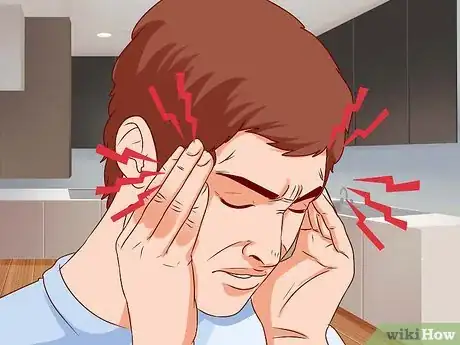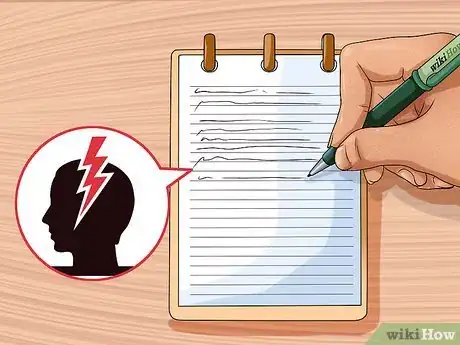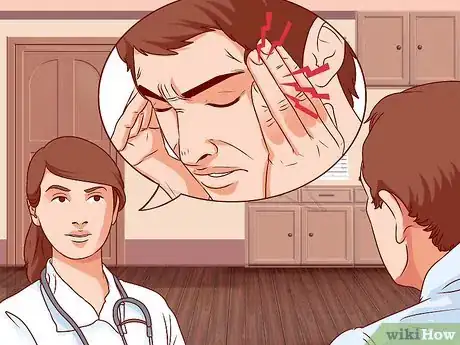This article was medically reviewed by Janice Litza, MD. Dr. Litza is a board certified Family Medicine Physician in Wisconsin. She is a practicing Physician and taught as a Clinical Professor for 13 years, after receiving her MD from the University of Wisconsin-Madison School of Medicine and Public Health in 1998.
There are 12 references cited in this article, which can be found at the bottom of the page.
wikiHow marks an article as reader-approved once it receives enough positive feedback. In this case, 85% of readers who voted found the article helpful, earning it our reader-approved status.
This article has been viewed 63,041 times.
People get headaches for all kinds of reasons. Migraine headaches, which can last from a few hours up to several days, are painful and difficult to get through. They affect about 12 percent of the population, and are three times more common in women than in men.[1] Migraines can be treated with rest and proper care, but to first you'll need to figure out if you are having one.
Steps
Checking if Your Headache is a Migraine
-
1Locate the pain. Migraine headaches involve an intense throbbing pain, usually on one side of your head. You may feel it in your temples, or behind either eye. The pain is constant, and it can last anywhere from four to 72 hours.[2]
- Migraine pain will come along gradually, so that you will probably notice your head starting to hurt a few minutes before the worst of the pain arrives.
-
2Look for other symptoms of a migraine. In addition to your headache, a migraine will bring other symptoms. The experience of a migraine is unique to each patient, and you may have some or all of them during your migraine headache. These symptoms include:[3]
- Sensitivity to light, sounds, and smells
- Nausea and vomiting
- Blurred vision
- Lightheadedness and fainting
- Symptoms that vary over time. As you get older, new migraines may bring different symptoms. The headaches themselves should still follow a regular pattern in terms of length and frequency. If that changes, talk to your doctor, as it may be the sign of another health problem.[4]
Advertisement -
3Check for triggers. Doctors are not completely sure what causes migraine headaches, but suspect they can be triggered by outside factors. Every person has different triggers, which include a variety of outside changes to your life or environment. If any of these things have changed in your life recently, your headache could be a migraine:[5]
- Unusual amounts of sleep, either too much or too little
- Skipped meals
- Extreme sensory overload from bright lights, loud noises, or strong odors
- Stress and anxiety
- Consuming certain chemicals in food such as nitrates (in hot dogs and lunch meat), MSG (in fast food and seasoning), tyramine (aged cheeses, soy products, hard sausages, and smoked fish), or Aspartame (artificial sweetener sold as NutraSweet or Equal)
- Menstruation (women may experience migraines due to hormonal changes that occur during their menstrual cycles.)
-
4Try some common physical activity. One characteristic of migraine headaches is that they are debilitating, making even the simplest tasks difficult. Try a simple physical activity like walking up the stairs. If that causes your pain to increase, or the pain is too great to even attempt it, you are probably suffering from a migraine.[6]
- If you can still perform basic physical tasks, even with some slight discomfort, you probably have a common tension headache, not a migraine.
-
5Look at the medication you are taking. There is no cure for migraines, but you can manage some of the symptoms with various medications. If these do not provide relief, you may need to discuss treatment with your doctor.[7]
- Over-the-counter ibuprofen (Advil, Motrin IB) and acetaminophen (Tylenol), along with rest in a dark room, can provide some relief if taken as the headache begins. If you suffer from migraines regularly, your doctor may have recommended additional medication like cardiovascular drugs or antidepressants to reduce the frequency of your headaches.
- Too much anti-headache medicine can actually cause additional headaches, which are not migraines. If you are taking over-the-counter or prescription medicine to help relieve headache pain, and have taken these medications for more than 10 days a month for three months, or in high doses, you could be suffering from a medication-overuse headache. If you have been taking medication frequently, and having additional headaches, stop taking it. You might be making things worse for yourself.[8]
-
6Look for sinus congestion. If your sinuses are congested, like when you have a cold, this can also give you a headache. A sinus headache, while painful, is not the same thing as a migraine. If you are congested, feel nauseous, are sensitive to light, and have a runny nose, it is probably a sinus headache.[9]
-
7Notice the frequency of your headaches. If you are experiencing headaches that are regular and brief, lasting 15 to 180 minutes up to eight times a day, these are cluster headaches. They are very rare, and more common in men between the ages of 20 and 40. Migraines last for several hours, and it will usually be at least several weeks before they reappear.[10]
- Cluster headaches are usually accompanied by other symptoms, including congestion, runny nose, forehead and facial sweating, and eyelids either dropping or swelling.
Noticing Your Migraine Before it Starts
-
1Look at your family history. As many as 90 percent of migraine sufferers come from families that have a history of attacks. If one or both of your parents suffers from migraines, there is a chance you will as well.[11]
-
2Watch for prodrome symptoms. The prodrome is the first step to getting a migraine, and can let you know one is coming. You may notice subtle changes in your health or mood one to two days before your headache that signal an oncoming migraine. About 60 percent of migraine sufferers will see certain symptoms before their headache. Some of the symptoms for prodrome can include:[12]
- Constipation
- Depression
- Food cravings
- Hyperactivity
- Irritability
- Neck stiffness
- Uncontrollable yawning
-
3Notice an aura. Anywhere from 10 to 30 minutes before an attack, you might begin to hallucinate certain symptoms. This is called an aura, and could mean that a migraine is coming. Only about one in five migraine sufferers experience an aura, and women far less so than men. If your aura symptoms last more than an hour, that could be a sign of bleeding in the brain — a stroke. If that is the case, you should see a doctor immediately. Symptoms of an aura can include:[13]
- Flashing lights, bright spots, or blind spots in your vision
- Numbness or tingling in your face or hands
- Aphasia, which is speech or language problems
-
4Keep a headache diary. By recording information about your headaches, you may be able to notice patterns to your suffering. This information can help you and your doctor figure out what is triggering your migraines, and how to stop them.[14]
- Your diary should include information about when you had the headache, how long it lasted, what kind of pain you felt, any other symptoms you noticed, and any treatments you tried. This information can help you and your doctor discover triggers and figure out the most effective treatments.
- This can also to help you identify the migraine early, which is beneficial because response to treatment is more effective during the prodrome or aura.
- Make sure to keep the diary after visiting your doctor and starting treatment. Not every treatment will work on you, so you'll want to make sure you find the best ones for you.
-
5Get tested. If you still aren't sure if your headaches are from migraines, your doctor can help you figure it out. There isn't any test for a migraine. Your doctor will just be asking about your symptoms. To help your doctor, make note of a few things to tell him:[15]
- Information about your headaches, including when and how often they happen, where the pain is, and how long they last.
- Other symptoms, including nausea or blind spots.
- Additional information, including a family history, any medicines you are taking, and any side effects those medicines may have had.
- If your headaches are particularly severe, your doctor may recommend other tests to rule out other potential causes, including blood tests, a CT scan, an MRI, or a spinal tap. These tests can't confirm that you have a migraine, but they will be able to prove other things are not causing your headaches.[16]
Expert Q&A
-
QuestionCan emotional stress cause migraines?
 Joel Warsh, MDDr. Joel Warsh is a board certified Pediatrician and the Owner & Founder of Integrative Pediatrics and Medicine in Los Angeles, California. With over a decade of experience, Dr. Warsh specializes in holistic and integrative medicine. He holds a Bachelor’s degree in Kinesiology and Health Sciences, a Master’s degree in Epidemiology and Community Health, and a Doctor of Medicine (MD) from Thomas Jefferson Medical College, where he was elected president of the Jefferson Pediatric Society. Dr. Warsh then completed his Pediatric Residency at Children’s Hospital of Los Angeles (CHLA), where he received the George Donnell Society Research Fellow.
Joel Warsh, MDDr. Joel Warsh is a board certified Pediatrician and the Owner & Founder of Integrative Pediatrics and Medicine in Los Angeles, California. With over a decade of experience, Dr. Warsh specializes in holistic and integrative medicine. He holds a Bachelor’s degree in Kinesiology and Health Sciences, a Master’s degree in Epidemiology and Community Health, and a Doctor of Medicine (MD) from Thomas Jefferson Medical College, where he was elected president of the Jefferson Pediatric Society. Dr. Warsh then completed his Pediatric Residency at Children’s Hospital of Los Angeles (CHLA), where he received the George Donnell Society Research Fellow.
Board Certified Pediatrician Finding different ways to decrease your stress can certainly help decrease or eliminate your migraine. In general, stress exacerbates everything in your body that's bad.
Finding different ways to decrease your stress can certainly help decrease or eliminate your migraine. In general, stress exacerbates everything in your body that's bad.
Warnings
- If your headache is accompanied by a fever, stiff neck, mental confusion, seizures, double vision, weakness, numbness, trouble speaking, go see your doctor immediately. These could be signs of other, more serious problems.[17]⧼thumbs_response⧽
- If you have an aura that lasts up to a week after your headache has finished, you may experience similar symptoms to a stroke. This may be a persistent aura without infarction, which is not a serious condition, but one you should check out with your doctor.[18]⧼thumbs_response⧽
References
- ↑ https://medlineplus.gov/migraine.html
- ↑ https://www.womenshealth.gov/a-z-topics/migraine
- ↑ https://my.clevelandclinic.org/health/diseases/5005-migraine-headaches
- ↑ https://www.migrainetrust.org/living-with-migraine/seeking-medical-advice/diagnosis/
- ↑ https://www.womenshealth.gov/a-z-topics/migraine
- ↑ https://my.clevelandclinic.org/health/diseases/5005-migraine-headaches
- ↑ https://www.nhs.uk/conditions/migraine/
- ↑ https://www.nhs.uk/conditions/migraine/treatment/
- ↑ https://www.womenshealth.gov/a-z-topics/migraine
- ↑ https://familydoctor.org/condition/migraines/
- ↑ https://familydoctor.org/condition/migraines/
- ↑ https://www.nhs.uk/conditions/migraine/symptoms/
- ↑ https://www.nhs.uk/conditions/migraine/symptoms/
- ↑ https://stanfordhealthcare.org/medical-conditions/brain-and-nerves/headache/diagnosis/headache-diary.html
- ↑ https://www.womenshealth.gov/a-z-topics/migraine
- ↑ https://www.radiologyinfo.org/en/info/headache
- ↑ https://my.clevelandclinic.org/health/diseases/9639-headaches
- ↑ https://www.heart.org/en/news/2018/05/01/migraine-with-aura-linked-to-clot-caused-strokes
About This Article
If you’re unsure if you have a migraine, figure out where exactly you feel the pain, since most people feel migraines on one side of their head, in their temples, or behind either eye. If you experience secondary symptoms, such as light sensitivity, nausea, lightheadedness, and blurred vision, you’re probably experiencing a migraine. You can also ask your family members if they’ve had migraines before, since many migraine sufferers have a family history of them. Another thing you should look out for is prodrome symptoms, which often occur before a migraine, such as constipation, depression, irritability, and uncontrollable yawning. For more tips from our Medical co-author, including how to identify migraine triggers, read on!





































































Medical Disclaimer
The content of this article is not intended to be a substitute for professional medical advice, examination, diagnosis, or treatment. You should always contact your doctor or other qualified healthcare professional before starting, changing, or stopping any kind of health treatment.
Read More...